Content
- 1 Standards and varieties of gherkins
- 2 Mini gherkins
- 3 Planting gherkin seeds
- 3.1 Choosing a place for the beds
- 3.2 Watering and feeding cucumbers
- 3.3 Possible problems when growing gherkins
- 3.4 Description of the variety
- 3.5 Advantages and disadvantages of the variety
- 3.6 Description of the variety
- 3.7 Advantages and disadvantages of the variety
- 3.8 Description of the variety
- 3.9 Advantages and disadvantages of the variety
- 3.10 Description of the variety
- 3.11 Advantages and disadvantages of the variety
- 3.12 Description of the variety
- 3.13 Advantages and disadvantages of the variety
- 3.14 Description of the variety
- 3.15 Advantages and disadvantages of the variety
- 3.16 Description of the variety
- 3.17 Advantages and disadvantages of the variety
- 3.18 Description of the variety
- 3.19 Advantages and disadvantages of the variety
- 4 Brief characteristics of gherkin cucumbers
- 5 Review of the best varieties for greenhouses
- 6 Features of growing gherkins in a greenhouse
Pickled cucumber is a favorite snack both on the festive table and in everyday use. Even specimens with small seeds and up to 10 cm in size are especially good.For the sake of gourmets, French culinary experts began to preserve small cucumbers in the 19th century, calling them gherkins.
How to grow gherkins
Standards and varieties of gherkins
Amateur gardeners often call ordinary cucumbers harvested during the period of milk ripeness and have not reached the standard size for their variety as gherkins. Meanwhile, the real gherkin is a separate variety, which has its own characteristics:
- fruit length is in the range of 5-8 cm;
- the cucumber has a bright green thin peel;
- dense pulp without voids;
- small unripe seeds.
Spiny gherkins
Zelentsy-gherkins, although they consist mainly of water (97%), like ordinary cucumbers, contain more useful trace elements and minerals.
Gherkins are good for your health
The most productive varieties of gherkins
Developing new varieties of gherkins, breeders strive to maximize the useful and taste qualities of fruits, the plant's resistance to various kinds of diseases. Gherkin hybrids are distinguished by enviable productivity, good keeping quality during transportation.
|
Parisian gherkin |
Pollination is required. Harvesting takes place in 42-45 days. The length of the gherkin is from 6 to 10 cm. Weight 65-90 g. Resistance to coolness and typical diseases of cucumbers. |
|
Fun company F1 |
Parthenocarpic mid-early variety. Productivity up to 9.5 kg / sq. m. The fruit is 7-9 cm long. Diameter 2.8-2.9 cm. Does not lend itself to root rot. |
|
F1 advance |
Ripening rate 39-44 days. Buds are formed in a bunch - up to 5 fruits per node. Ripens in 40-44 days. Disease resistant. Productivity up to 13 kg / sq. m. |
|
Gerda F1 |
Mid-season (48-50 days). Does not require pollination. Bunch type of ovary, 3-5 fruits per bunch. Cucumber size 8-10 cm. Weight 70-75 g. Resistant to overgrowth and deformation. Not prone to damage by powdery mildew (true and false). |
|
Diva F1 |
Ultra-ripe (35-40 days). Fruiting is observed during the entire vegetative period. Resistance to cold snaps and typical diseases. Fruit size is from 10 to 11 cm. |
The number of varieties of gherkins is constantly growing. The popularity of this subspecies of cucumber forces breeders to work on the creation of new names. In addition to those listed, there is a whole galaxy of varieties that demonstrate excellent characteristics - F1 Cappuccino, F1 Quadrille, F1 Mumu, F1 Mademoiselle.
Mini gherkins
Gherkin varieties
The peculiarity of cucumbers, called mini-gherkins, is their ability to acquire full commercial qualities (taste, fruit density, crunchiness) in small-sized specimens. They can be harvested when they reach a length of 3-4 cm - while such "babies" are fully matured, they can be subjected to all types of processing (canning, pickling).
|
F1 Micron |
The growth period is 35-45 days. Bee-pollinated. The maximum size is 6-8 cm. Long-term fruiting. Resistant to overgrowth and typical cucumber diseases. |
|
F1 Philippok |
Mid-season (45-50 days). Large lumpy white thorn fruit. Bee-pollinated. Resistant to cucumber mosaic virus and downy mildew. Productivity up to 10kg / sq. m.Commercial qualities are achieved when a length of 3-5 cm is reached. |
|
Son of the F1 Regiment |
Mid-season with white thorns. The length of the fruit is 6-7 cm. It bears fruit for a long time and abundantly. Resistant to diseases and viruses. Retains excellent taste in the pickle phase (2-4 cm). |
|
F1 Spring |
Early (36-42 days). Does not require pollination. Fruiting until autumn, the ability to harvest 2-3 crops from the bush. Maximum length 7-8 cm. Resistant to real and downy mildew. Differs in the proportionality of the fruits. |
Cucumbers mini-gherkins require constant harvesting - in 1-2 days. Despite the fact that most hybrids are not prone to overgrowing, a delay in harvesting is an obstacle to the formation and filling of new ovaries.
Planting gherkin seeds
Planting gherkin cucumbers can be done both by seeds, immediately in the prepared bed, and by seedlings grown at home. The seedling method will help to get the harvest 12-14 days ahead of schedule.
How to sow gherkins correctly
Show on page Open in full size
Important. Gherkins have an extremely delicate root system, so seeds for seedlings should be placed in peat pots or paper cups filled with earth. So the roots will not be damaged during handling.
Seeds can be planted during the period when a steady heat has come, the soil temperature does not drop below 12-130 C. Usually, the mass sowing of cucumber seeds occurs in the third decade of May. To avoid diseases of the greenery caused by hypothermia, the bed for gherkins can be additionally warmed up with the help of a film - in such cases, special slots are provided for the sprouts.
The seeding rate depends on the variety of gherkins - specific recommendations are indicated on the bag. In general, it is assumed that you need to sow 3 g of seeds per 1 m2.
When planting in the ground, the distance between the holes should be 30-35 cm, in each "nest" it is enough to place 4-5 seeds or 2-3 plants in the form of seedlings.
Sowing patterns for cucumber seeds
Choosing a place for the beds
For gherkins, loose and light soils with an acidity level of 6 to 7.5 pH are good. If the soil is excessively acidic, then it is advisable to carry out preliminary liming. The introduction of organic matter during the autumn digging of the garden will increase the fertility of the soil and supply it with the necessary amount of nitrogen.
Introduction of organic matter into the soil
Gherkin is a capricious culture for both light and cold. Cucumber beds are best made in the form of ridges, with a slope to the south - so they will be protected from the north wind. In order to avoid hypothermia of the soil during late spring frosts, special mobile beds with film insulation can be made for gherkins.
Cucumbers in a high garden
To prepare a warm bed, it is necessary to lay thin old branches in layers on a marked area in a sunny place, then plant residues that have not decayed and garden soil. After spilling any bed with an ash solution (1 glass per bucket of water) and a humus mash, it is covered with a black film and left to ripen for 25-30 days.
We build warm beds
How to make a warm bed
After this period, you can plant seeds that are guaranteed to give a high yield.
Watering and feeding cucumbers
Watering cucumbers
To ensure the continued growth of gherkins, it is important to regularly water and feed on time. At the initial stage of development, the soil under the cucumbers must be moistened with an interval of 3-4 days. The amount of water is up to 10 liters per hole. With significant watering, the development and growth of the root system improves, which will make the plant stronger and more resistant to negative influences and diseases.
In the fruiting phase, the greens should be watered every day, in the early morning or in the evening. If the weather is excessively dry and hot, then watering and irrigation of gherkins must be done up to three times a day.
Fertilization when growing gherkins is carried out by the fertigation method, i.e. with preliminary dissolution of mineral dressings in water for irrigation. This method of supplying nutrients to the soil provides good efficiency and prevents overfeeding of plants.
Fertigation features
Gherkins need regular nitrogen, phosphorus, magnesium and potassium supplementation. In order not to exceed the recommended feeding rates and to avoid active growth of leaf mass, mineral fertilizers are applied in the following quantities:
- phosphorus (superphosphate) - at the rate of 15-20 g / m2, with an increase of up to 30 g / m2 on poor soils;
- magnesium - 1.5-2 g per 10 square meters;
- potassium salts - 10-25 g / m2.
Top dressing at the growth stage is carried out in the flowering phase - if the plant has developed normally before. For this, a complex fertilizer is used with the obligatory presence of nitrogen - ammofosk or azofosk. Organic solutions can be used - herbal infusion, horse manure or bird droppings.
Ammofoska station wagon
Chicken manure solution for feeding cucumbers
As soon as the gherkins begin to actively bear fruit, they need additional nutrition. After the appearance of the first fruits, nitrophoska is introduced (1 tbsp. Spoon per bucket of water), and after 7-10 days, a second root feeding is carried out - 1 tsp of potassium sulfate and 0.5 kg of cow dung per 10 liters of water.
After that, during the entire fruiting period, complex fertilizer or herbal infusions are applied weekly. It is especially important to use a universal fertilizer - potash nitrate. This drug helps to improve the taste of cucumber.
Potassium nitrate
Interesting! Gherkins react well to yeast feeding. A pack of dry yeast (10-11 g) is dissolved in 10 liters of warm water, and after fermentation has begun, the mixture is diluted with another 50 liters of liquid. This fertilizer stimulates the active growth of the plant; it can be applied twice a season.
Yeast for plant nutrition
Possible problems when growing gherkins
When growing gherkins in an open area, problems often arise that significantly reduce the yield of the crop and can even completely destroy the plants:
- damage by pests - possible with improper use of organic fertilizing (insufficient incorporation of manure into the soil);
Cucumber pests
- yellowing and swelling of the tops - caused by watering in sunny hot weather, the accumulation of water on the leaves when covered with a film at night;
Cucumber leaves turn yellow
- slow growth of young shoots of gherkin - arises from the large number of weeds that take all the nutrients from the soil;
- "Different sizes" of fruits - manifests itself when the harvest is uneven - gherkins, not harvested on time, outgrow, and young fruits cannot develop fully;
Fruits of various sizes
- disease - the cause may be too dense planting of seeds, which contributes to the development and preservation of infections and viruses.
Compliance with the rules of agricultural technology - sufficient (but not excessive) watering, timely introduction of nutrients, the formation of a cucumber bush and, most importantly, the use of high-quality varietal material - a guarantee that until autumn gherkins will delight vegetable growers.
Video - Seeds of cucumbers Parisian Gherkin
Video - Wagner F1 (Wagner F1) parthenocarpic cucumber-gherkin
Gherkins are the best pickles for canning. They fit easily into even the smallest jar with a narrow neck. It is worth noting the high taste of pickled cucumbers. This article will focus on gherkin cucumbers, about the characteristics of the most popular varieties of mini-cucumbers.
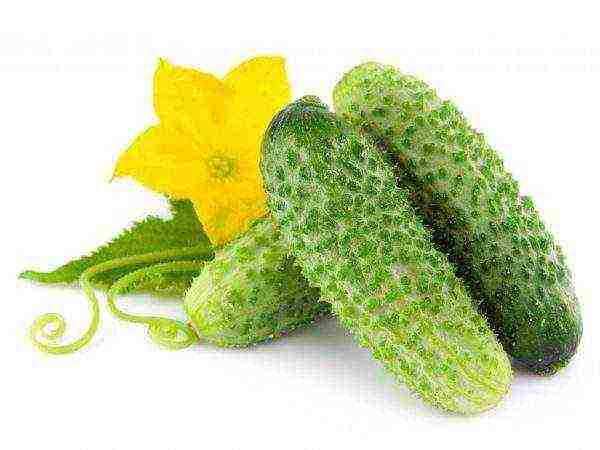
The best varieties of gherkins
Parisian gherkin
This is an early ripe hybrid of French selection that can be grown both outdoors and in a greenhouse.
Description of the variety
A gherkin-type vegetable ripens in 45 days.In the open field, it is recommended for cultivation in central Russia. Ripe fruits are in the shape of a cylinder. Their length is on average 1-9 cm. On the surface of small cucumbers there are pronounced pimples, on the peel there are stripes of light green color. The average weight of one fruit is 70 g. From 1 sq. m, with proper care, 3-4 kg of fruits are harvested. During the fruiting period, cucumbers are harvested every day.
The Parisian gherkin is not self-pollinated. This makes it somewhat difficult to grow in a greenhouse. This variety is pollinated by insects, therefore, during the flowering period, it is necessary to ensure the presence of bees in the greenhouse.
There are manual methods of pollination that require a considerable investment of time: they collect pollen from male flowers with a brush and carefully transfer them to female ones. This is almost a piece of jewelry.
Advantages and disadvantages of the variety
Gherkins of this variety are valued for their high taste and good yield indicators. Another advantage of the variety is resistance to fungal diseases and high temperatures.
As for the shortcomings, cucumbers, when untimely harvesting, take the form of barrels. Since the Parisian gherkin is a hybrid variety, its seeds do not germinate well. Second generation hybrids are less productive and more susceptible to disease. Accordingly, seeds will have to be purchased every year in specialized stores.
Micron F1
This early ripe variety was bred not so long ago. It is recommended to grow it in a greenhouse.
Description of the variety
Under favorable conditions and proper care, Micron F1 yields a harvest already 38 days after planting. The bushes are medium-sized and medium-branched. The variety is pollinated by bees. The shape of the fruit, the weight of which varies from 60 to 80 g, resembles an ellipse. Their length is, on average, 8 cm. Pickles, the length of which does not exceed 4 cm, or mini-cucumbers 5 cm long, can be collected. The fruits have excellent taste. On the green peel there are pronounced pimples. From 1 sq. m collect up to 15 kg of cucumbers. Micron F1, due to its dense pulp structure, is suitable for canning and pickling.
Advantages and disadvantages of the variety
An important characteristic of Micron F1 is that it bears fruit throughout the summer. In addition, gherkin is resistant to almost all diseases. Micron is not prone to overgrowth, which makes harvesting easier.
There are no obvious flaws in the variety. The disadvantages of growing are associated with the need to pollinate the vegetable crop and purchase seeds from the store every year.
Mels F1 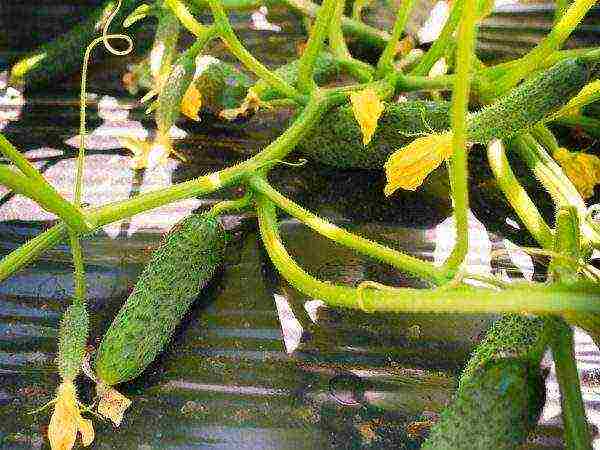
The variety is distinguished by its early maturity.
This hybrid is perhaps the most popular today. Its popularity is due to characteristics such as early maturity and yield. Gherkins of this variety can be grown both in greenhouses and in the open field.
Description of the variety
Mels F1 is an early ripe cucumber. It gives a massive harvest 35 days after planting, which is not typical even for early maturing varieties that begin to bear fruit closer to 38-39 days after planting. It is a self-pollinated plant, making it easy to grow in greenhouses.
This is a gherkin of a bouquet-type ovary. During flowering, several nodes appear on each branch, each of which gives up to 6 ovaries. During the fruiting period, more than 200 fruits are harvested from one plant. But such results can be achieved subject to the norms of agricultural technology, which include:
- timely landing in the ground;
- feeding the culture;
- watering and loosening.
The length of the cucumbers is, on average, 9 cm. In shape, the oblong gherkins resemble an elongated ellipse. The peel is green, pronounced pimples are covered with white fluff.
Advantages and disadvantages of the variety
The advantage of the Mels F1 variety is that its fruits, dense in structure, are never bitter. Mels F1 hybrid is resistant to various diseases and is not afraid of sudden temperature changes. He, regardless of weather conditions, gives high yields.
No flaws were found in this hybrid variety.
Novosibirsk gherkin F1
It is a mid-season hybrid suitable for outdoor cultivation.
Description of the variety
The growing season of the plant is 45-49 days. The hybrid belongs to bee-pollinated. A medium-sized plant has long branches. The average weight of cylindrical fruits is 75 g. The average length of cucumbers is 10 cm, weight is 70 g. The rind is dark green, there are tubercles with small black thorns. In ripe cucumbers, the peel on the back turns yellow-green. From 1 sq. m collect about 5 kg. These are average yields. The yield of an ordinary variety Altai Waterfall, for example, is the same 5 kg.
Novosibirsk gherkins are suitable for making fresh salads and preserving. Crispy fruits with dense pulp are extraordinarily aromatic.
Advantages and disadvantages of the variety
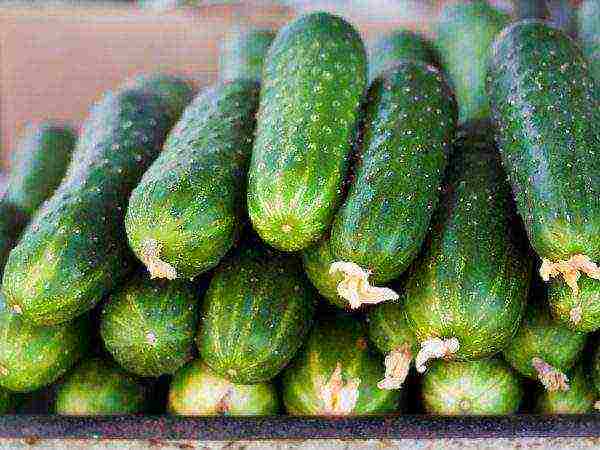
It is important to prevent overripening of fruits.
The main advantage of the Novosibirsk gherkin is that it gives equally good yields in all weather conditions. The hybrid is resistant to fungal diseases, especially powdery and downy mildew.
Ripe fruits are prone to overripe, so they need to be harvested every day. This is a disadvantage of the hybrid.
Firestarter
This is a bunchy hybrid, the care of which requires the correct formation of the bush. For maximum results, the side shoots are removed, leaving one stem.
Description of the variety
The growing season of the hybrid is 38-40 days. On the cucumber whips of the early ripe hybrid, many greens are formed. After ripening, the length of cylindrical fruits is 9 cm, weight - 90 g. The peel is light green, white stripes are present. The aromatic and crunchy pulp never tastes bitter.
Cucumbers Perfection itself is used both for preparing fresh salads and for preserving. They can be picked unripe. Pikuli have the same taste as ripe fruits.
Advantages and disadvantages of the variety
The main advantage of the hybrid is its high yield. From 1 sq. m collect up to 30 kg of mini-cucumbers. The hybrid is resistant to changes in climatic conditions, with good watering it easily tolerates high temperatures. As for the disadvantages, these include the tendency to overripe.
Moravian gherkin F1
These are open field gherkins.
Description of the variety
The growing season of the bee-pollinated hybrid is 45 days. The first ripe cucumbers appear in 41 days. Bushes are tall, with short branches. In one internode, from 2 to 4 cucumbers are tied. Ripe cylindrical fruits have a length of 9 cm and a weight of 75 g. The peel is dark green in color. The yield of the Moravian gherkin hybrid is 6-7 kg per 1 sq. m. The crop is harvested daily. Most often, the Moravian gherkin is used for rolling.
Advantages and disadvantages of the variety
The main advantages of the Moravian gherkin are disease resistance and independence from weather conditions. It produces equally good harvests in both hot and cold summers.
Patty 
Patti is suitable for balcony cultivation
Self-pollinated hybrid Patti - a variety of breeders of the Moscow company Sedek. It can be grown not only on a personal plot, but also on a balcony.
Description of the variety
The growing season of a mid-season Patti hybrid ranges from 40 to 45 days. The ovaries in the sinuses are formed in bunches. Productivity - 24 kg per 1 sq. m, but this is an average figure. Subject to the norms of agricultural technology, the yield indicator reaches 37 kg per 1 sq. m.
The length of ripe cucumbers of a cylindrical shape is 10 cm, weight - 75 g. The peel is dark green, white pubescence is present, thorns are prickly. The fruit has a sweetish taste, the flesh is tender and moderately crunchy.
Advantages and disadvantages of the variety
According to the description, one of the main advantages of Patti is the high density of the pulp.The hybrid is also appreciated for its high yield and transportability.
Champion
This hybrid is adapted to the climatic conditions of Russia. It is suitable for cultivation even in the north of the country.
Description of the variety
This early maturing hybrid is suitable for outdoor cultivation. The length of ripe fruits varies from 10 to 12 cm, weight - 90 g. Gherkins are covered with a dark green skin, pubescence is practically absent. As for the taste, cucumbers have a sweetish aftertaste. The yield is 25 kg per sq. m. Despite the average density of the pulp, the Champion is used for various methods of preserving and preparing pickles.
Advantages and disadvantages of the variety
Cucumber gherkin Champion has excellent taste. It has a long fruiting period and is disease resistant.
Superbundled cucumbers (10-12 ovaries in a knot (!) A cucumber avalanche will overwhelm you!
Kornishon cucumber varieties #urozhainye_gryadki
CUCUMBER SEEDS 🥒 The best bee-pollinated cucumbers for open ground and greenhouses 🥒 HitsadTV Review
Open field cucumbers 29 06 2016 Care, varieties
Cucumbers. Gherkins and pickles
Noteworthy are the hybrids of the Belarusian and Ural gherkins, Druzhnaya family, Moth and Marinade. But they are less popular.
Similar articles

Reviews and comments
Gherkins are both a great appetizer and a decoration for any table. Many varieties of this subspecies of cucumbers are distinguished by high productivity and excellent taste, their selection does not stop. They are grown in different ways - in closed and film greenhouses or in the open field. And the choice of the best varieties of gherkins for greenhouses is of undoubted interest for gardeners.
Brief characteristics of gherkin cucumbers

Gherkins are an independent subspecies, and not just small cucumbers
The name "gherkin" comes from the French language, it means small cucumbers intended for pickling or pickling. This is an independent subspecies of cucumbers, and not any greenery no more than 9 cm in size, as some mistakenly suggest... Gherkins are narrow, cylindrical in shape, with shallow grooves and faint gloss, tuberous and with thorns. There are varieties with light stripes, but they are all dense, without bitterness, and inside without voids and with small grains. Gherkins are not prone to outgrowth when they reach maturity, their average size is 5-9 cm. Smaller greens are already pickles.
In addition to their pleasant taste, these cucumbers have a number of dietary and even medicinal properties. They are much richer in minerals than other types of greens, and besides, they are low in calories. Thanks to iodine, gherkins help in problems with the thyroid gland, improve digestion, normalize acidity, gastric and intestinal motility. These cucumbers contribute to the elimination of cholesterol, improve metabolic processes, and are successfully used in cosmetology for skin problems.
Gherkins can be used to make healthy, nourishing face masks. For this, both cucumber circles and fruits chopped in a blender are used.
Review of the best varieties for greenhouses
For growing gherkins in greenhouse conditions, it is especially important that hybrid varieties are resistant to fungal diseases and other infections, which can develop especially quickly in warmth, with high humidity and overcrowding of plants.... These qualities, coupled with unpretentiousness and good yield, fully compensate for the increased costs of seeds of hybrids, in the names of which F1 is always present.
In greenhouses, parthenocarpic (self-fertile) and self-pollinating varieties of gherkins are mainly grown, which makes it possible to do without pollinating insects. The first category has only female flowers that can set without pollination, and these greens have no seeds. Consider several interesting varieties of gherkins suitable for greenhouse cultivation.
Friendly family
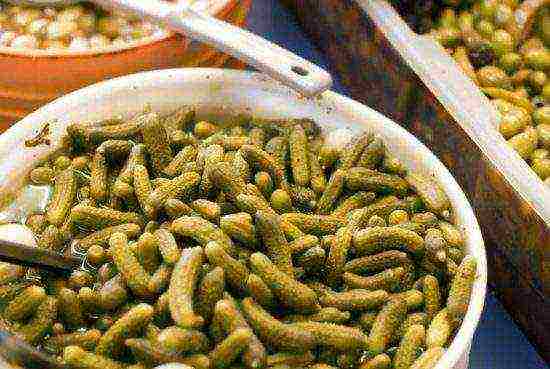
The Druzhnaya Semeyka gherkin variety is one of the best for pickling
A mid-early variety with the onset of fruiting one and a half months after the emergence of sprouts. The length of oblong greens is not more than 12 cm, 6-centimeter fruits are considered mature. They have white thorns on a green background, bumps of medium size. Up to 4 ovaries appear on the main shoot, and twice as many on the lateral ones. The flowering type is female, they require pinching and pinching. Up to 20 kg of cucumbers are harvested from a square meter of a garden bed, they are used fresh and canned.
Sweet crunch
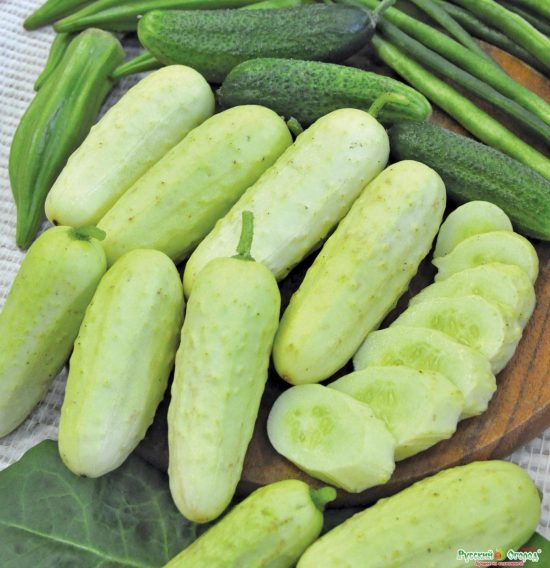
Gherkins "Sweet Crunch" are much paler than their relatives
This variety is distinguished by the color of the fruits, they are light green, almost white, of the correct shape. On the skin there are dark thorns and large tubercles. The weight of the excellent taste greens reaches 70 grams, they are universal in use.
Mels F1
This hybrid variety is widespread due to its fast ripening and high yield; mass ripening occurs earlier than other early-maturing hybrids - on the 35th day. Self-pollinating plant with a bouquet type of ovaries, of which there are up to six in each node. Thanks to this, two hundred 9-centimeter elliptical greens can be collected from the bush. They are dense, do not give bitterness, green with pimples covered with white fluff.
Patti F1

Patti F1 is particularly prickly
A self-pollinating hybrid of Moscow selection of the mid-season (up to one and a half months), 24-30 kg of 10-centimeter zelents weighing up to 75 g are harvested from a square. They are dark green with white pubescence and thorny thorns, their tender, dense pulp has a sweetish taste.
Brownie F1
It is an early maturing (up to 50 days) parthenocarpic hybrid with a pleasant taste and aroma, growing up to 13 cm long. From a bush, you can collect up to 9 kg of multi-purpose greens. They weigh more than 100 g, are dark green, with frequent tubercles and white thorns.
Child F1
Mini-gherkin is self-pollinating, blooms profusely, belongs to varieties of medium ripening. Has a decorative appearance of a bush with small leaves, white thorn green with tiny tubercles, crisp in taste. It grows up to 8 cm long and weighs 70 g. Up to 17 kg of fruits are harvested from the square.
Nastya F1
This is an early (up to 40 days) self-pollinating hybrid, green leaves up to 8 cm long and weighing up to 80 g. Its fruits are crispy, white-lumpy with small thorns. Up to 26 kg of greens are collected from the square.
Red mullet F1
This is a mid-season variety of a bundle-shaped female flowering type with strong branching. In the leaf sinuses, up to 12 ovaries are formed. Cylindrical greens with large tubercles and dark green skin grow up to 12 cm and weigh up to 100 g. They have mild light stripes and white thorns of medium pubescence. Up to 7 kg of multipurpose greens are collected from the bush.
Courage F1
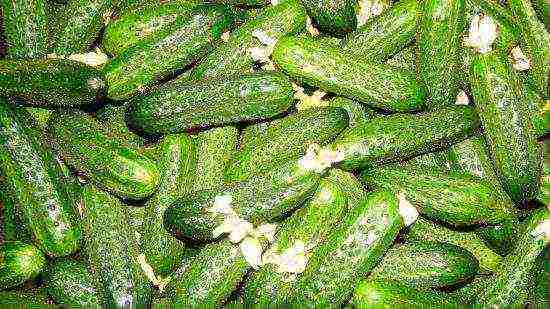
This variety, bred in India, perfectly adapted to the Russian climate.
This hybrid gherkin belongs to the early maturing type with the female flowering type. Up to 6 ovaries appear in each node, greens more than 12 cm long weigh up to 120 g. They are lumpy, white-thorny, of universal purpose, 6–8 kg of fruit are harvested from the bush.
Phillipoc F1
This is a mid-early parthenocarpic hybrid variety of universal gherkins. Strongly branching plants with green, cylindrical cucumbers with long stripes. They are covered with white pubescent spines and medium-sized tubercles. Their length is no more than 9 cm, and up to 10 kg of crispy cucumbers are harvested from a square.
Features of growing gherkins in a greenhouse
Even an inexperienced gardener can grow a good harvest of gherkins in a greenhouse, however, there are certain conditions and rules that must be followed.
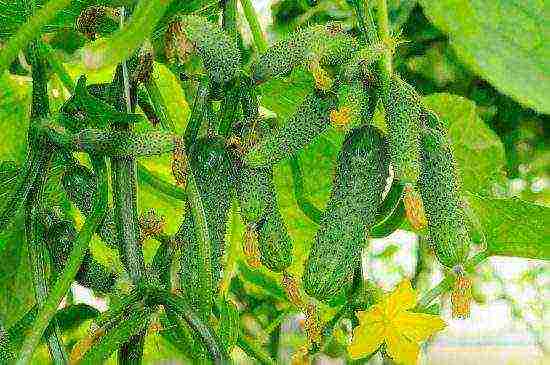
Growing in a greenhouse allows for an earlier harvest
Soil preparation
Gherkins need a high-quality earthen mixture, consisting of fresh humus with turf... They are also suitable for soil from 2 parts of ordinary earth, 5 parts of peat and 3 parts of humus.
Soil preparation is done immediately after harvest. Wherein:
- All plant residues are carefully removed.
- They dig up the beds to a depth of 20 cm.
- The earth is disinfected with a 7% solution of copper sulfate.
- A month after that, 2 kg of potassium sulfate, one and a half times more superphosphate and half a kilogram of ammonium nitrate are added to the soil for each cubic meter.
- The prepared soil is placed in greenhouses with ridges.
During the cultivation of cucumbers, make sure that the soil is not compacted. To do this, it is regularly loosened, trying not to damage the roots located near the surface.
Sowing seeds

Seeds are planted in heated soil
It is better to sow gherkin seeds in separate boxes with drainage holes so that you do not have to dive them later. They are placed in moist soil to a depth of one and a half centimeters, watered and slightly compacted the earth.
From above, the planting is covered with a film that prevents rapid evaporation of moisture and accelerates seed germination. At first, you need to maintain the temperature in the greenhouse at 25-28 degrees, and after the sprouts appear, it drops by 5 degrees during the day, and at night it should be kept at a 17-degree mark. It is important for the root system of plants that the temperature drops are small.
If the seeds are sown directly into the soil, then it must be preheated, the sowing density is 3 seeds per square meter.
After the emergence of seedlings, the cucumbers are tied up, and the stepsons and whiskers that take away the strength of the slightly grown plants are removed.
Watering and humidity
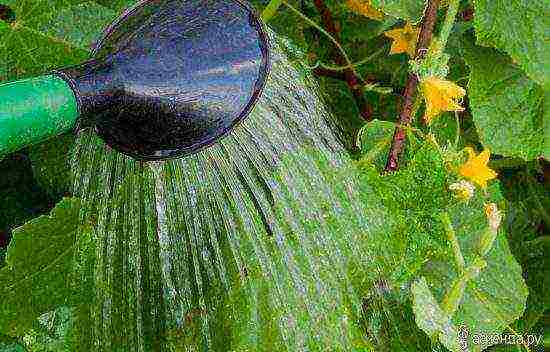
If you water gherkins with a watering can, be sure to put a spray on it.
For the normal development of plants, it is necessary to maintain constant humidity in the greenhouse and water the plants regularly... Otherwise, the roots may crack, and this is fraught with the appearance of root rot. In the heat, you need daily watering, it is better to do this in the evening with heated water.
To prevent the soil from crusting after watering, a sprinkler is put on the hose or watering can. Watered carefully, not allowing water to get on the leaves, and then loosen the surface of the earth. If the roots are bare, then they are covered with a one and a half centimeter layer of soil.
To prevent the air in the greenhouse from becoming dry, it is necessary to ventilate it regularly. To avoid drafts, only the upper vents are opened.
Top dressing gherkins
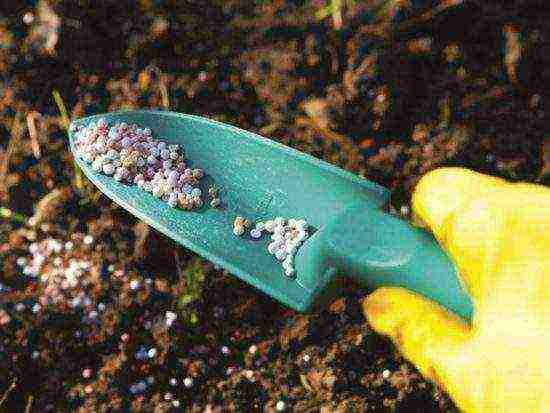
If you follow all the recommendations for feeding and fertilizing, the harvest will be good.
Productivity allows you to increase timely and competent feeding, during the season they are dosed 4–5 times by root and foliar methods. The following rules are observed:
- For the first time, the cucumbers are fed before flowering with a balanced composition of "Solution A" or similar.
- The second time fertilizers are applied in a couple of weeks, repeating the feeding 3-4 more times.
- For better fruit setting and development, potassium nitrate is applied once.
- For flowering plants and fruit setting, phosphorus is also needed.
- Nitrogen is applied only once at the very beginning, since by stimulating the growth of the green mass, it harms the quality of the fruit.
Experienced vegetable growers advise:
- Feed the gherkins with water from soaked bread crusts.
- To prevent diseases, soak horse sorrel or nettle for a couple of weeks. A mug of solution is diluted in a bucket of water and watered with gherkins.
- To attract pollinating insects to the greenhouse (if necessary), bouquets of dandelion, oregano or other flowers are placed at the entrance to the greenhouse. It is useful for this purpose to spray plants with sweet water.
Gherkins are called a variety of cucumbers about 10 cm in size. For their cultivation in greenhouses, self-pollinating varieties that are resistant to infections are mainly used. Caring for them is easy, and harvesting begins within a couple of months after sowing the seeds.
Rate the article:
(2 votes, average: 5 out of 5)

Small pickled cucumbers are an integral part of almost every feast. They are liked by many summer residents, who plant different varieties to their taste, giving small and tasty fruits. By the way, gherkin is not a variety, but a size, so you can collect it from different plants. About how to choose the right gherkin varieties, why salad greens are best suited for these purposes, and how to properly carry out agricultural techniques - further. Also from this review you will learn how and where the variety of small cucumbers appeared, what yield can be harvested on your site, and what you need to know about pest control of crops.
Feature and Description
Gherkins are a size, not a variety of cucumbers. That is, it is theoretically possible to collect them from any crops, although salad dressings give the most delicious (in this case juicy and crunchy) fruits. Pick gherkins 1-2 days after the appearance of the ovaries - when the length of the fruit is several centimeters (usually no more than five). Even such small unripe cucumbers are quite tasty, deliciously crunchy and ideal for preservation. The characteristics of the fruits are directly dependent on the type of plant grown on the site. If you want your harvest to be tasty, beautiful and not bitter, choose appropriate crops.
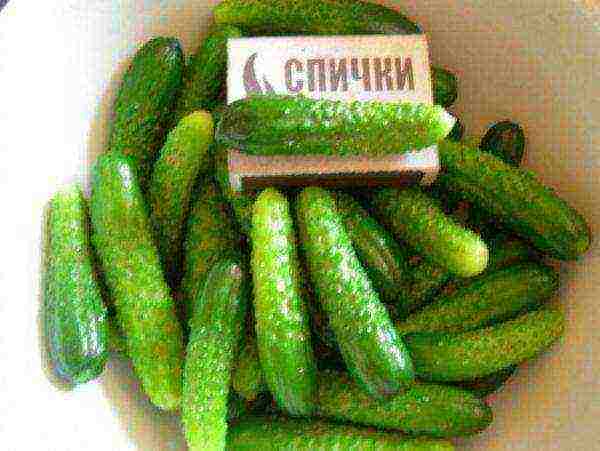 Gherkins differ from other cucumbers in their size.
Gherkins differ from other cucumbers in their size.
Gherkin (from French cornichon) are small cucumbers from 3 to 5 cm long, removed immediately after the end of the flowering of the cucumber plant. They are used mainly for pickling, salting.
Peculiarities
Small cucumbers came from France - it was the French breeders who set the fashion for crunchy small fruits. Do not confuse gherkins with pickles - yes, some gherkins can be pickles, but not all. The first type of cucumber grows up to a maximum of 9 cm, and usually no more than 5. It is a several-day-old fruit, which, from the point of view of botany, are rather ovaries. And the second type is any small-sized pickled vegetables. That is, pickles can be cucumbers, tomatoes, onions, carrots, even corn cobs.
 Gherkins are native to France
Gherkins are native to France
Gherkins have a number of differences from common pickled and salad cucumbers. The main ones are high density and the absence of voids, due to which the vegetable turns out to be crispy.
Gherkins are cylindrical in shape and have a bright green color (the Meringue cucumber is a good example). The ripening time is short, the taste is high, the bitterness usually does not have time to acquire the fruits in a few days from the moment the ovaries are formed. Another important advantage of gherkins is their versatility (they can be pickled, salted, used for making salads, canapes, they can be eaten in their pure form). The hybrids are resistant to most pests, the yield is good. The only disadvantage of the cucumber variety is the presence of thorny thorns.
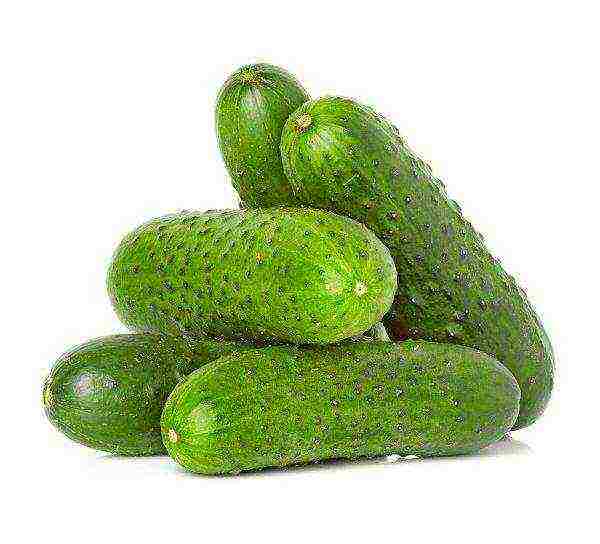 Gherkins are cylindrical in shape and have a bright green color.
Gherkins are cylindrical in shape and have a bright green color.
The correct choice of the variety is the key to the successful cultivation of delicious gherkins. Most Popular:
- "Parisian gherkin" - early maturing culture, pollinated by bees. The first harvest is taken 41 days after planting in the ground. Fruits reach 6-10 cm in size.
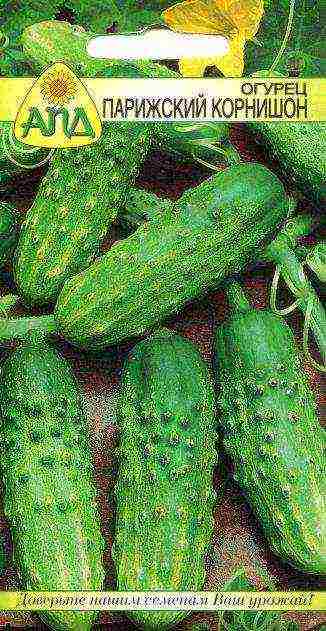 Cucumber variety "Parisian gherkin"
Cucumber variety "Parisian gherkin"
- "Moravian gherkin F1" has high taste, grows in the ground no worse than in greenhouses.
- "Gerda F1", "Kai F1"- these varieties have similar parameters and give a good harvest even in conditions of lack of heat.
- "Advance F1" - early ripening culture with excellent taste characteristics, fruit length is 7-9 cm.
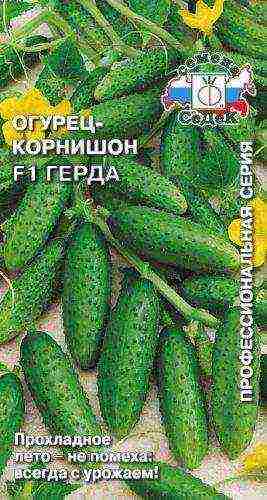 Cucumber variety "Gerda F1"
Cucumber variety "Gerda F1"
- "Thumbelina F1" - an early ripe variety, unpretentious in terms of storage and transportation.
- "Accordion player F1" - the culture has the longest fruiting period, bundle ovaries are formed during the growing season.
- "Chinese sustainable" - a hybrid with high immunity, which is not afraid of most diseases.
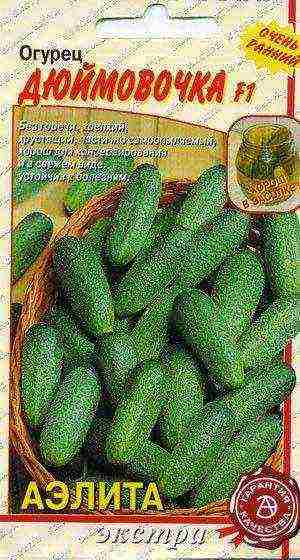 Cucumber variety "Thumbelina F1"
Cucumber variety "Thumbelina F1"
Mini gherkins are harvested a few days after flowering ends.
Growing
Gherkins are grown outdoors and in greenhouses. At the initial stages after planting in open ground, it is advisable to cover the culture with a film. Basic landing rules:
- If the seeds have been treated with thiram, they do not need to be soaked. Planting material is lowered directly into the ground or into peat pots.
- Gherkins are transferred to open ground when the soil is sufficiently warmed up.
- The pick is performed 25 days after landing. Seedlings are planted in open ground when 4 leaves appear (around the end of May).
When planting in the hole, it is recommended to apply 15 g of nitrogen fertilizers - this way the bush will grow better... Instead of nitrogenous compounds, you can use mineral dressings, sand, humus and peat. Seeds are laid to a depth of 2 cm from the upper layers of the soil, the beds are always mulched.
 To obtain a large volume of yield, add mineral and organic fertilizers to the soil
To obtain a large volume of yield, add mineral and organic fertilizers to the soil
For gherkins to grow well, do not plant them in the sun (the rays can burn the leaves), and choose corn as a neighbor.
The optimal distance between seedlings is 30 cm, it is recommended to pinch the shoots and ovaries after the appearance of the first four leaves (this is necessary to strengthen the root system). Continue pinching the shoots until 8-9 leaves appear, then it should be stopped. If you choose to grow vertically, don't forget about the garter.
Watering the bushes during flowering is enough once a week, after the appearance of the ovaries, this will need to be done more often - after 2-5 days. In greenhouses, watering is carried out every two days, the greenhouses must be ventilated - this helps to normalize humidity and reduces the likelihood of being affected by various cucumber diseases. It is undesirable to water during the day of planting.
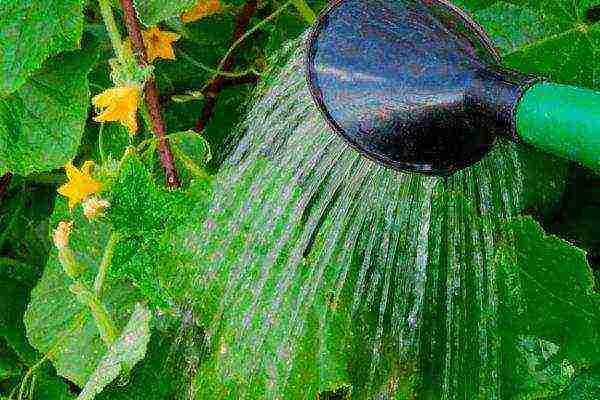 It is necessary to water the plant in a timely manner, preventing the soil from drying out
It is necessary to water the plant in a timely manner, preventing the soil from drying out
Top dressing is carried out every two weeks or a little more often. Fertilizers - an aqueous solution of urea or carbamide. When moisture is absorbed, the soil is loosened and mulched. The average number of dressings per season is 5-6.
Yield
You need to harvest from the bushes often - every few days. Mini-hybrids are unlikely to outgrow 5-9 cm, but until the old fruits are removed, new ones are not tied. The minimum plant growth period is 35 days (depending on the variety), from one bush, subject to the rules of caring for it, you can collect 10 kg or more per square meter. The number of harvests is 2-3 per season. The fruiting period of gherkins lasts from June until about the end of August or early-mid September. At the end of the season, the fruits must be harvested periodically, do not wait until they reach their maximum size.
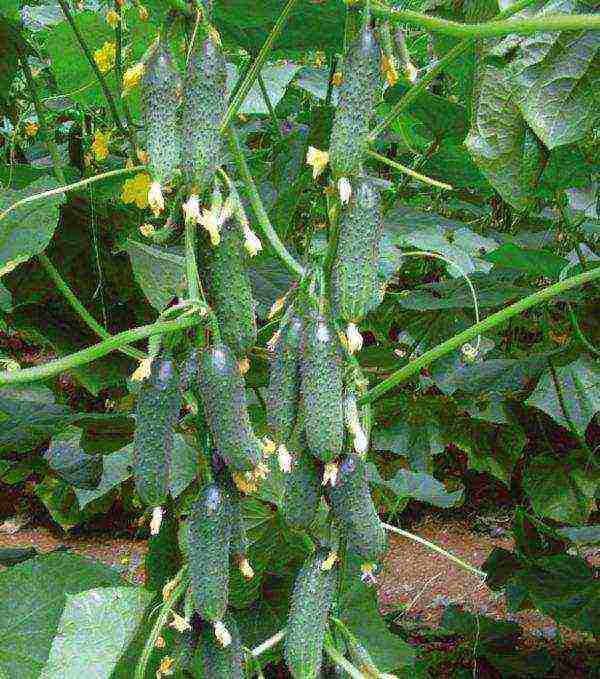 The yield is up to 10 kg per square meter
The yield is up to 10 kg per square meter
Varieties of mini-gherkins acquire full commercial qualities in small-sized specimens. That is, a 3 cm long cucumber will be fully ripe.
Diseases and pests
Consider the most popular diseases and pests of gherkins:
- Rust - brown spots appear on the shoots. To combat rust, plantings are treated with fungicides.
- Peronosporosis (or downy mildew) - whitish spots on the leaves indicate infection to her, which eventually cover the entire green part of the plant.
- Aphid - when infected with this pest, the leaves curl, the flowers begin to wither and crumble. Treatment with infusion of ash, soap and tobacco helps. Some gardeners use infusions of garlic and onions to combat aphids.
- Spider mite - green leaves turn yellow and die. To combat the tick, use a soapy solution and carry out preventive digging.
- Gall nematode - causes a slowdown in plant growth and a decrease in yield.To combat rootworm nematode, steam treatments are carried out.
Many hybrids are highly resistant to diseases and pests, but each has its own weak point. For example, the popular gherman variety "Herman" is often affected by rust.
Video
conclusions
Gherkins are small crunchy cucumbers that are harvested in the first days after ovary formation... Different varieties can be used, the most popular are disease and pest resistant hybrids. Planting is carried out by seeds and seedlings, in open ground or in a greenhouse. The crop is harvested 2-3 times per season, depending on the variety.

